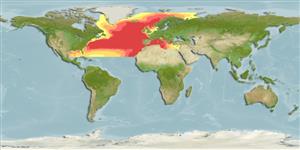Actinopterygii (ray-finned fishes) >
Myctophiformes (Lanternfishes) >
Myctophidae (Lanternfishes) > Lampanyctinae
Etymology: Lampanyctus: Greek, lampas, -ados = torch + Greek, nykte = night (Ref. 45335).
Environment / Climate / Range
Ecology
Marine; bathypelagic; oceanodromous (Ref. 51243); depth range 0 - 1192 m (Ref. 56504). Deep-water, preferred ?; 75°N - 22°N
Eastern Atlantic: strays as far north as Dohrn Bank (off East Greenland) and off northwest Iceland, from British Isles to Mauritanian Upwelling Region including the Mediterranean (Ref. 4479). Western Atlantic: as shallow as 46 m in Ungava Bay, Canada, in slope water region (Ref. 5951).
Size / Weight / Age
Maturity: Lm ? range ? - ? cm
Max length : 30.0 cm SL male/unsexed; (Ref. 4479)
Dorsal
soft rays
(total): 13-14;
Anal
soft rays: 16 - 18. Distinguished from other species of Lampanyctus by the pattern of its photophores and by its short pectoral fins located just behind gill opening (Ref. 5571). Photophores along ventral post-anal region (AO): 6 (7) + 8 (7-9) = 14 (13-16) (Ref. 4775).
High-oceanic, between 700-1,000 m during the day (with juveniles in the upper 200 m) and 45-250 m and 4000-1,000 m at night (Ref. 4479). Depth range from 318-1192 m in the eastern Ionian Sea (Ref. 56504). Epipelagic to bathypelagic, feeds on zooplankton (Ref. 58426). Catches of lanternfishes off the west coast of South Africa: 1,134-42,560 mt (Ref. 5571). Minimum depth from Ref. 58018.
Life cycle and mating behavior
Maturity | Reproduction | Spawning | Eggs | Fecundity | Larvae
Apparently spawns in deepwater.
Bauchot, M.-L., 1987. Poissons osseux. p. 891-1421. In W. Fischer, M.L. Bauchot and M. Schneider (eds.) Fiches FAO d'identification pour les besoins de la pêche. (rev. 1). Méditerranée et mer Noire. Zone de pêche 37. Vol. II. Commission des Communautés Européennes and FAO, Rome. (Ref. 3397)
IUCN Red List Status (Ref. 115185)
CITES (Ref. 94142)
Not Evaluated
Threat to humans
Harmless
Human uses
Fisheries: of potential interest
More information
ReferencesAquacultureAquaculture profileStrainsGeneticsAllele frequenciesHeritabilityDiseasesProcessingMass conversion
Tools
Special reports
Download XML
Internet sources
